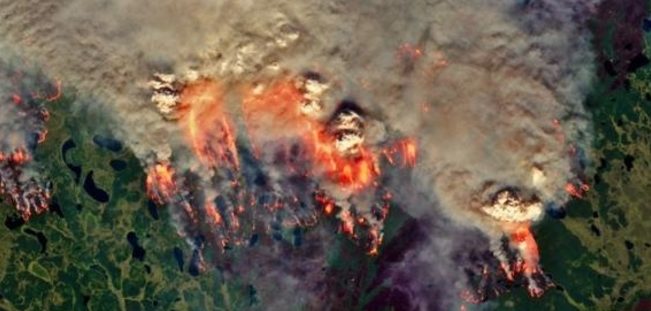Exceptional and prolonged heat in Siberia has fueled unprecedented Arctic fires, with high carbon emissions, the World Meteorological Organization (WMO) has said, adding that at the same time, rapidly decreasing sea ice coverage has been reported along the Russian Arctic coast.
As a result of this confluence of conditions, the northernmost inhabited Arctic town, Longyearbyen, on the Norwegian archipelago of Svalbard, saw a new record temperature of 21.7°C on July 25, compared with the July average of 5.9°C, according to Norway’s national meteorological service.
The WMO’s data shows that temperatures in Siberia have been more than 5°C above average from January to June, and in June up to 10°C above average. A temperature of 38°C was recorded in the Russian town of Verkhoyansk on June 20, and temperatures in parts of Siberia the week beginning July 19 again topped 30°C.
The organization stated that observations show the prolonged heat is related to a vast blocking pressure system and a persistent northward swing of the jet stream, enabling warm air into the region. Nevertheless, it said such extreme heat would have been almost impossible without the influence of human-caused climate change, according to a rapid attribution analysis by a team of leading climate scientists.
“The Arctic is heating more than twice as fast as the global average, impacting local populations and ecosystems and with global repercussions. “What happens in the Arctic does not stay in the Arctic. Because of teleconnections, the poles influence weather and climate conditions in lower latitudes where hundreds of millions of people live,” said WMO secretary-general Petteri Taalas.
Satellite images from Europe’s Sentinel 3 satellites showed that the wildfires currently affecting Siberia inside and outside the Arctic Circle cover a width of about 800km. The fire front of the northernmost currently active Arctic wildfire reached over the 71.6N, less than 8km from the Arctic Ocean.
The WMO noted that July 2020 has witnessed an escalation in Arctic fires previously unseen in the EU Copernicus Atmosphere Monitoring Service Global Fire Assimilation System data. The fires have been particularly intense in Russia’s Sakha Republic and Chukotka Autonomous Okrug in the far northeast of Siberia, both of which have been experiencing much warmer-than-usual conditions over the past months. Russian authorities have also declared that there is an extreme fire hazard throughout the Khanty-Mansiysk Autonomous Okrug – Yugra, in western Siberia.
The Siberian heatwave has accelerated ice retreat along the Arctic Russian coast, most notably since late June, leading to very low sea ice extent in the Laptev and Barents Seas. However, in contrast, the other areas of the Arctic seas appear to be near the 1981 to 2010 average for this time of year.
The WMO noted that such contrasts serve as prominent examples of the larger variations that occur for sea ice extent on the regional scale, in comparison with the Arctic Ocean as a whole.



